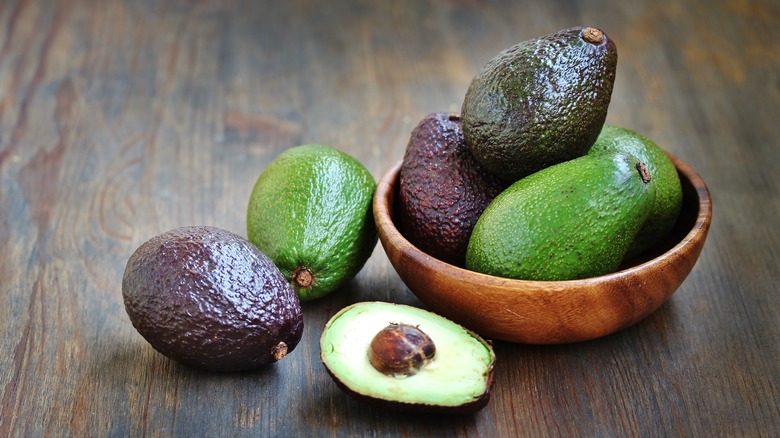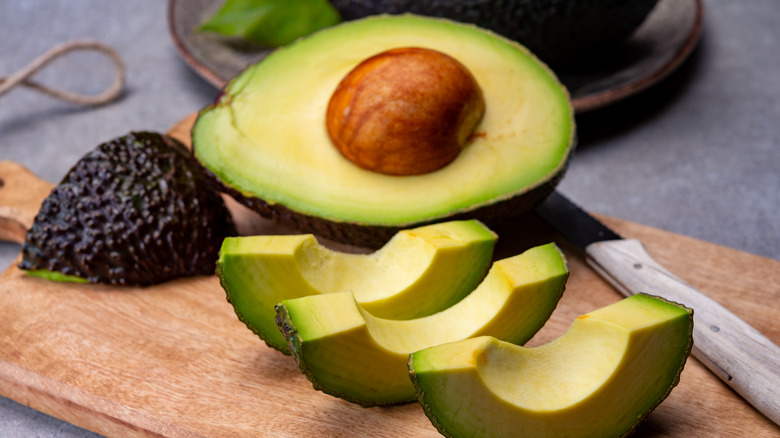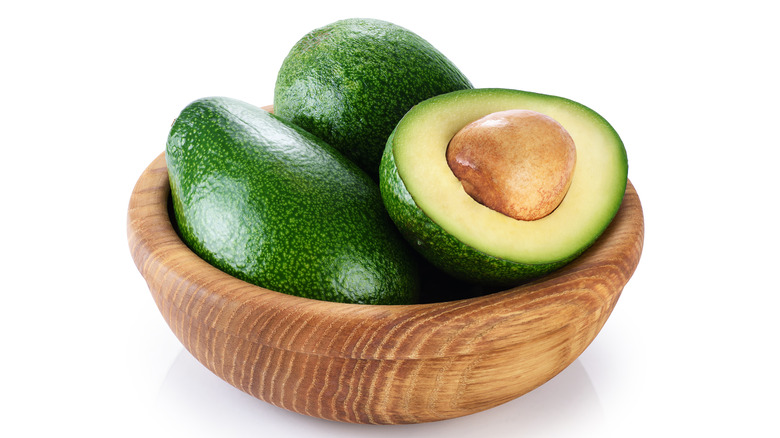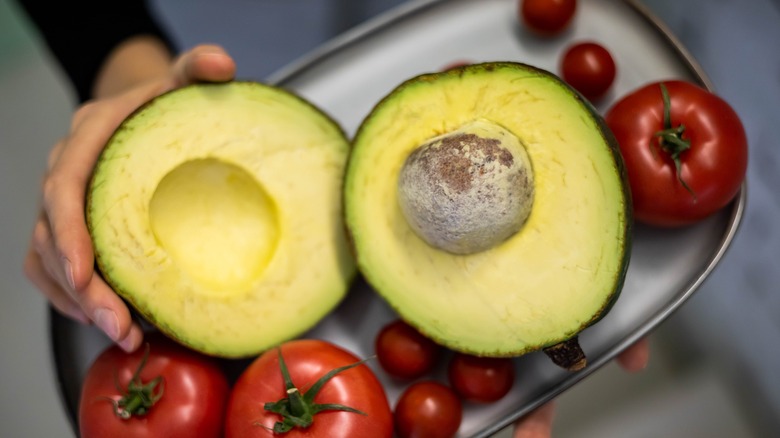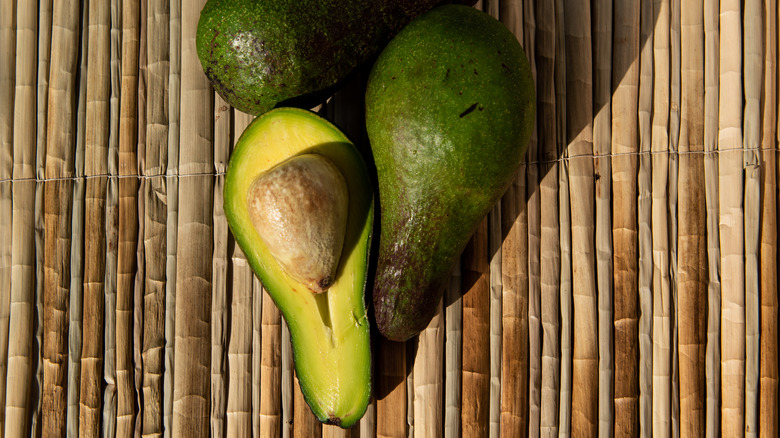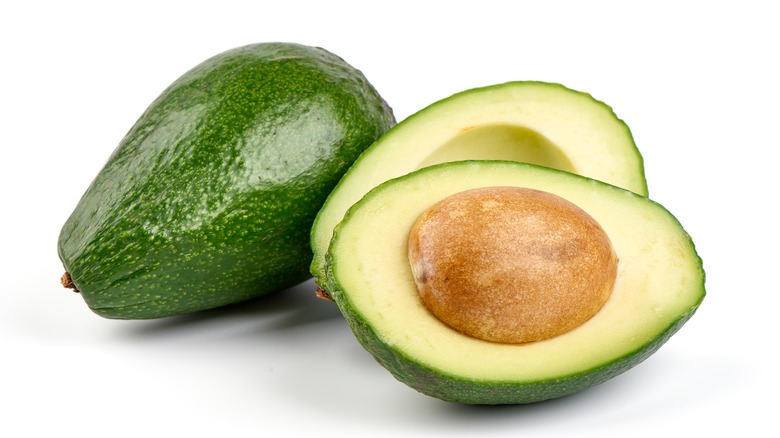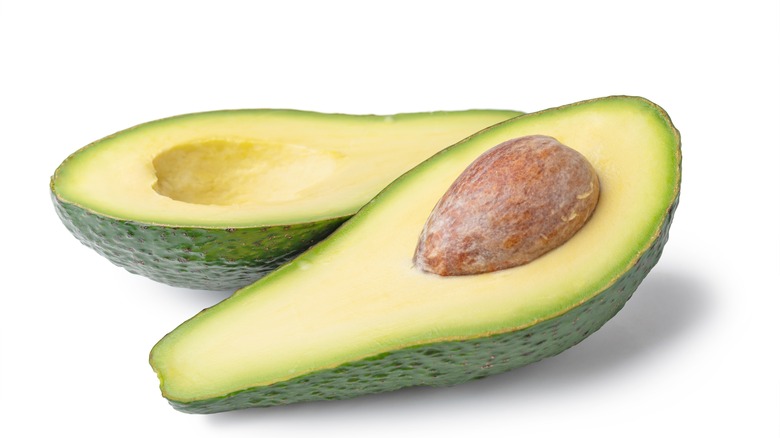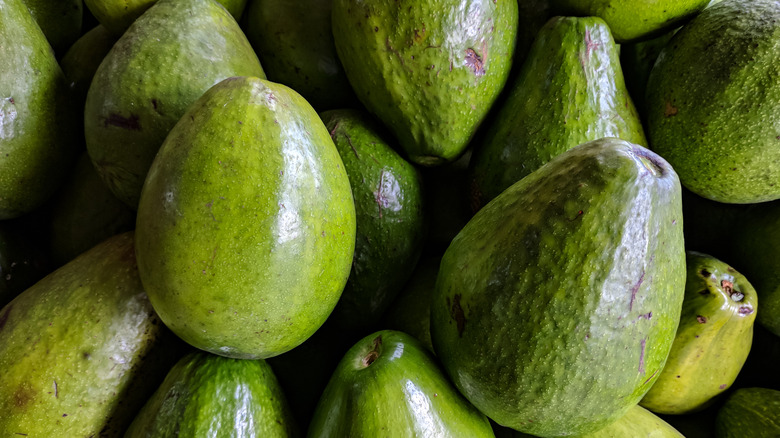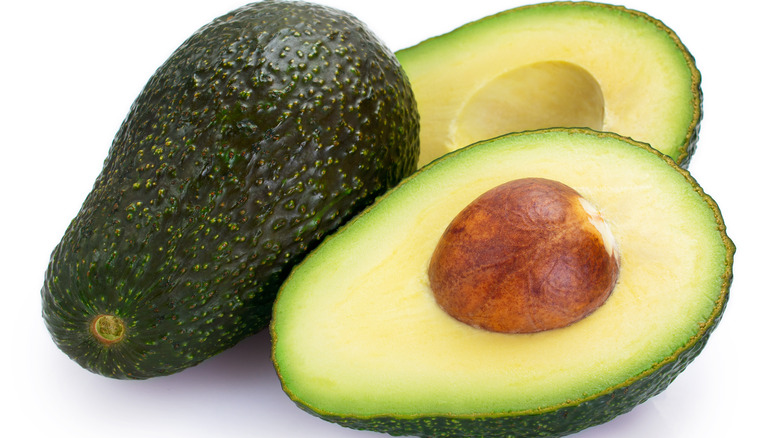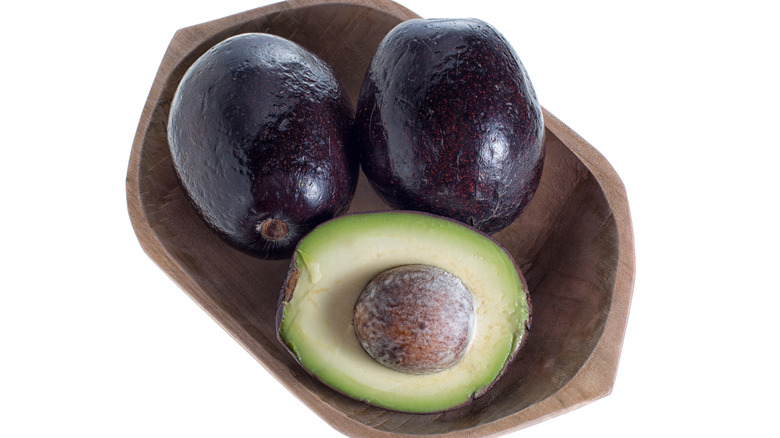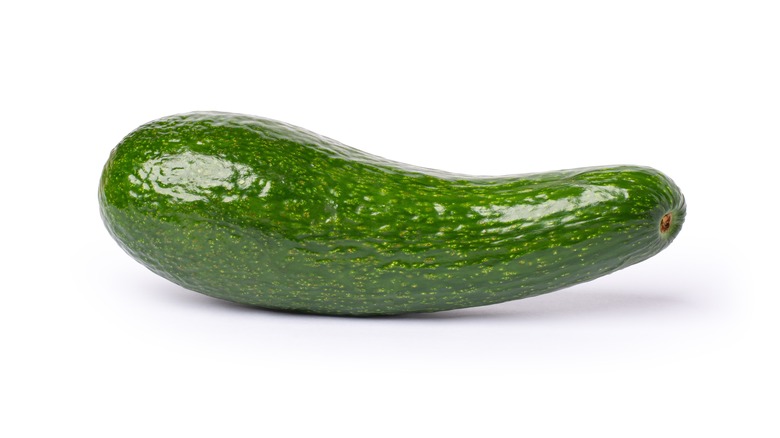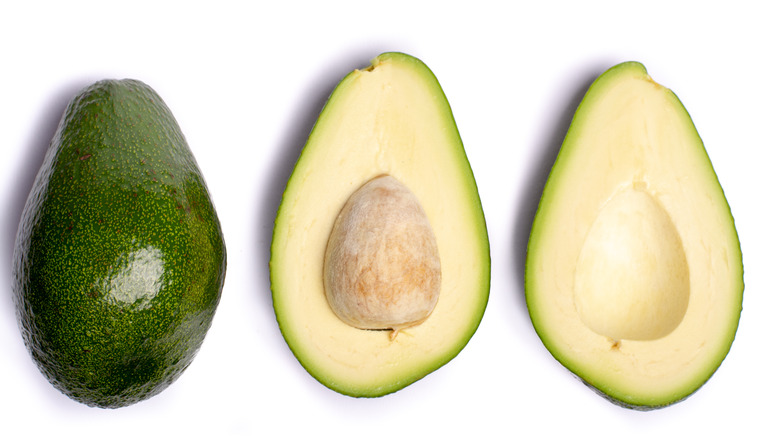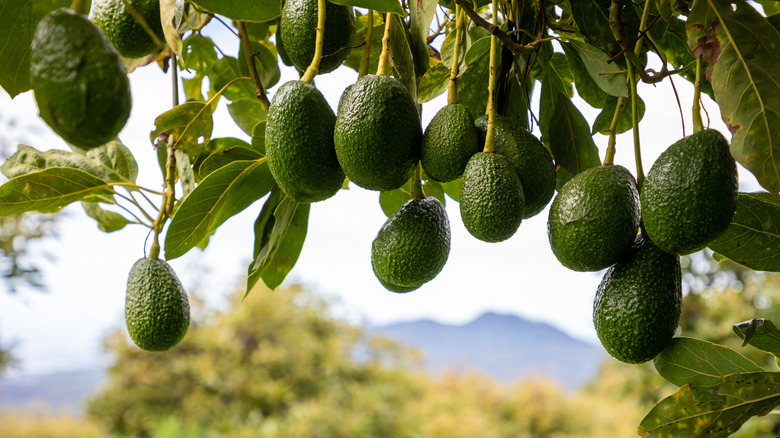12 Varieties Of Avocados, Explained
Few foods have swept the nation as avocado has. With their alluring green and buttery flesh, irresistible creaminess, and nutritious natural fats, avocados are a super food that not only makes you feel good but is also delicious. So, how nutritious are avocados? According to Harvard University, avocados are a fantastic source of healthy fats, fiber, and vitamins such as C, B, and E. Now available in most grocery stores, the majority of the world's avocados are grown in Mexico. At the same time, California accounts for 90% of the avocados grown in the U.S., with Florida and Hawaii as runner-ups.
Jeff Wasielewski, a tropical growing extension agent at the University of Florida, explains that the Hass avocado is the most popular variety in the world. But do not be deceived! While the Hass variety may be the only avocado you are used to seeing, there are many others. Jeff Wasielewski says that most of the country's Hass and Bacon avocados are grown in California, while other lower-fat content avocados, like the Monroe, are explicitly grown in southern Florida, where it is very tropical. Some avocados are great for cooking and baking, others are lighter in flavor, and some are rich and creamy. If you are an avocado lover, or even if you are not, there is a variety for everyone.
Hass
The Hass avocado originates from sunny California, where the vast majority of the U.S.'s avocados are grown. In 1920 the first Hass avocado tree was planted by Rudolph Hass, and ever since, the Hass avocado has been a hot commodity. With pebbly, dark green, almost black skin and weighing from five to 12 ounces, Hass avocados are a fan favorite across the U.S. (via Specialty Produce). Perfect for any salad, toast, or dip today, this avocado variety is so beloved it accounts for 95% of avocado sales across America.
Avocados are nutritious and delicious. It is undeniable that avocados are nature's butter, besides actual butter, of course, and this has made their global demand skyrocket in the past couple of decades. Hass avocados have taken the lead in this green wave of avocado-everything because of the tree's high yield and flavor.. This makes Hass avocados relatively affordable to grow and absolutely delicious to eat. Expert avocado grower Jeff Wasielewski further explains that Hass avocados are so popular because of their high fat content, which makes them very creamy and, therefore, irresistible.
Bacon
While no, Bacon avocados have nothing to do with actual bacon, they are absolutely delicious! According to Produce Market Guide, Bacon avocados are ovular in shape and have dark green skin that is easy to peel. The inside fades from a dark green around the outer edge, to a lighter green towards the pit, while the flesh maintains a mild flavor. Bacon avocados are a popular alternative to the Hass variety. Jeff Wasielewski says that many of the Bacon avocados in the U.S. are grown in California and Mexico, where the climate is mild and sunny.
These avocados were not named after a breakfast staple but after James Bacon, the first Bacon avocado farmer who bred this variety in 1954 (via Daily Harvest Express). What sets Bacon avocados aside from other avocados, besides their name, is that they are incredibly easy to peel and have a nutty, light flavor. This makes them a fantastic choice for your next sandwich, where you can indulge in two types of bacon: crispy bacon and creamy Bacon avocados.
Reed
Do you love scoping avocado straight from the skin, seasoning it with a tiny dash of salt, and then savoring all the buttery goodness in one big bite? Well, if you do, the Reed avocado is the perfect avocado for you. One of the largest avocado varieties, Reed avocados can grow to be larger than a softball and weigh over a pound (via Specialty Produce), meaning that one avocado will become a feast. More importantly, Reed avocados are often celebrated as the best-tasting avocado variety thanks to their rich, nutty flavor.
Reed avocados are classified as type A avocados, meaning their skin remains green even when ripe. Type B avocados like Hass become very dark, almost black, when ripe. Therefore, if you get a Reed avocado, Specialty Produce recommends that you gently squeeze your avocado to see when it is ripe. If the flesh feels tender – stop squeezing! It is probably ready to eat. If you only have the appetite for one half, you can store the other half of the avocado in a water bath to keep it from oxidizing.
Lula
A beautiful characteristic of the Lula avocado is its heartiness to cold, meaning that the trees can produce, when healthy, in temperatures as low as 25 degrees Fahrenheit (via Yarden). Compared to other tropical varieties, this sets the Lula apart. If you are lucky enough to have a Lula avocado tree, you can expect your fruit to be ready in mid-October. You can do a taste test around this time and see if the flavor and texture are spot-on.
Lula avocados are pear-shaped, with a slender neck and large central pit. Their flesh fades from yellow in the center to a light green around the edge and is mild and nutty in taste. They also have an exquisitely creamy texture, making them perfect for eating plain. But what if you get your hands on a coveted Lula avocado that is not ripe and want to eat it now? Don't worry; you can do a couple of things to help your avocado ripen faster, like putting it in a paper bag with a banana.
Gwen
If you have ever seen a Gwen avocado tree compared to a different avocado variety, do not be deceived — it is probably done growing! Classified as dwarf trees, Gwen avocado trees remain relatively small, topping out at 15 feet, making them perfect for a backyard avocado grove. If you have a Gwen avocado tree, you will know that your avocados are ready to be harvested when the first few fall off of the tree, says Jeff Wasielewski. Wasielewski explains that, like mangoes, avocados rarely change color to indicate ripeness, so you must know your region and your tree to determine when the fruit is ready to be picked. If the avocados that fall ripen in a couple of days, the other fruits that size are probably fair game.
Despite the tree's small size, Gwen avocados are actually quite large, ranging from six to 15 ounces in weight and maturing into a round, spherical shape (via Specialty Produce). This variety will ripen perfectly if left out on the counter for a couple of days, but if you are really in a crunch, make sure you are following the right tips on how to improve your avocado-picking skills. Then you can have a delightful Gwen avocado whenever you want. Once your Gwen avocados are ripe, they are perfect for guacamole because their excellent taste and texture combine well with the acid and spice in a nice guacamole.
Pinkerton
Believed to be a cross between a Rincon and Hass avocado, the Pinkerton avocado has the same black skin as a Hass avocado but the heartiness of a Rincon. This makes them both delicious and great avocados for larger production because they travel well. Also considered to be a Guatemalan variety, the Pinkerton avocado holds up well post-harvest but not as well in frosty weather (via Specialty Produce).
Pinkerton avocados, with their high oil content and easy-to-peel skin, are perfect for a summer lunch or any breakfast. They go well with other acidic or salty sides like olives and capers, so next time you want to dress up your classic avocado toast, try adding pickled red onions for an additional crunch and burst of brightness. The sweetness and acidity from the onions will pair beautifully with the creamy richness of the avocado, creating the most irresistibly balanced and satisfying bite. Make sure to toast your bread to bring an additional layer of texture, and maybe even drizzle your toast with a bit of olive oil to compliment the avocado's fat. You won't get enough of this delectable yet simplistic meal!
Monroe
When compared to other avocado varieties, the Monroe avocado is quite distinct. Weighing sometimes over two pounds and sporting glossy, smooth, green skin, the Monroe avocado is beautiful and delicious (via Avocado Buddy). Jeff Wasielewski explains that this cultivar is grown mostly in tropical southern Florida. It is also a more fussy variety and likes to stay warm all year round. This makes Monroe avocados more difficult to find in other parts of the country, but if you do find one, it is a real treat. They can be identified by their weight, smooth skin, round pit, and mild flavor.
With a lower fat content, the Monroe avocado can bring a lot of brightness to a dish without overwhelming it with the butteriness that some other avocados have. In recipes with other bold flavors, sometimes it is wise to choose a lighter-flavored avocado that can still bring body, creaminess, and brightness to a dish without overwhelming the palate. Next time you are whipping up some avocado egg salad, try making it with a Monroe avocado. However, if you cannot get your hands on one of these giant, green jewels, another mild-flavored avocado would still do the trick.
Malama
Malama avocados are harvested in the fall, and only after they are harvested do they fully ripen. Once a Malama avocado is ready to eat, it is divine. With dark green, almost purple skin, and yellow-green flesh that is very creamy, smooth, and fiberless, the Malama avocado will soon become your new favorite avocado variety (via Specialty Produce).
Avocados are generally split into three distinct groups: Guatemalan, Mexican, and Caribbean. Malama avocados are considered a hybrid of these groups and actually originate from the Kona region of Hawaii, which is also famous for growing coffee. Next time you pick out your avocados, try a new variety like the Malama. Choosing the best avocado does not have to be daunting, and with the right tips, like knowing how firm your avocado should be and the perfect color for that variety, you will be able to devour them in no time.
Brogden
It is a shame that Brogden avocados have such thin skin because if they did not bruise so easily, this variety would be everywhere. Brogden avocados are also anomalies in the avocado world thanks to their cold tolerance. While other avocado varieties cannot withstand low temperatures, Brogden avocado trees can survive in temperatures as low as 18 degrees Fahrenheit, making them perfect for more temperate climates (via Avocado Buddy).
So what do these incredible avocados look like? All avocados at one point were known as alligator pears, says Jeff Wasielewski, and today the Brogden variety has held onto that nickname. Due to their shape and dark skin, Brogden avocados do resemble pears with the same leathery, black skin as an alligator. Weighing 14-24 ounces, Brogden avocados are also a larger variety but with a similar flavor profile to the beloved Hass. Thanks to their high-fat content, Brogden avocados are perfect for creamy applications like avocado fettuccine alfredo or avocado hummus.
Russell
Russell avocados, a long-neck variety, are truly a sight to behold. Identifiable by their undeniably long neck that can reach up to 13 inches in length and curve almost like a gourd (via Specialty Produce), Russell avocados look almost nothing like the classic Hass avocados you are probably used to seeing. They have glossy green skin and light green flesh that is best eaten sliced or in cubes. Jeff Wasielewski explains that the Russell avocado is a variety specific to Florida and is also part of a group of avocados known as "green skin avocados." These avocados have, you guessed it, green skin and a lower fat content. Because of this low-fat content, the flesh of Russell avocados is fairly watery, meaning that it pairs well with fruits and other flavorful ingredients.
Originally grown in parts of Florida and the Caribbean, Russell avocados, and most long-neck avocado varieties, remain available only in this part of the world. Their production is still very localized, meaning that if you get your hands on a Russell avocado, you should do your best to savor it and enjoy every bit of this delicious fruit.
Fuerte
With skin so smooth it often appears shiny, the Fuerte avocado is quickly becoming a contender against the beloved Hass. Fuertes are fruitier than Hass avocados, and some claim that they even have notes of hazelnut that are brought out by the flesh's natural sweetness. Compared to the Hass, Fuerte avocados are not nearly as creamy, so that is one thing the Hass variety has over them. Other than fat content, Fuerte avocados rival Hass in many ways and their deeper flavor is preferred by many.
Originating from Mexico but developed in California, the Fuerte avocado derives its name from the tree's temperature resilience. The only tree to survive a devastating freeze in 1913 that killed many Avocado trees in California, the Fuerte variety was named the Spanish word for strong. If you find a Fuerte avocado, make sure to treat it with respect and prepare it in a way that will celebrate its natural flavor and creamy texture. To help, follow these avocado hacks that can help any home cook master avocado preparation.
Cleopatra
The Cleopatra avocado is the second dwarf avocado on this list, yet while the tree is relatively small, the fruits remain quite large. With black skin that turns even darker when ripe, Cleopatra avocados also have a rich yellow-green flesh that is creamy in texture (via Incredible Edibles). Similar in flavor to the Hass avocado, it is common to find Cleopatra-Hass hybrids because this enables the tree to produce a higher yield and creamier fruit (via Springvale Garden Center).
The Cleopatra variety should be a strong contender if you are looking for a backyard avocado tree. Growing three meters high and wide in the first ten years, it is the perfect compact avocado tree that will produce delicious avocados. According to Jeff Wasielewski, avocado trees need a constant supply of nitrogen, phosphorus, and potassium (NPK) to maintain growth and fruit production. You can add these fertilizers through granular application, fish fertilizers, or worm castings, to name a few. So, if you plant a little avocado grove, keep feeding your trees so they can keep feeding you!
